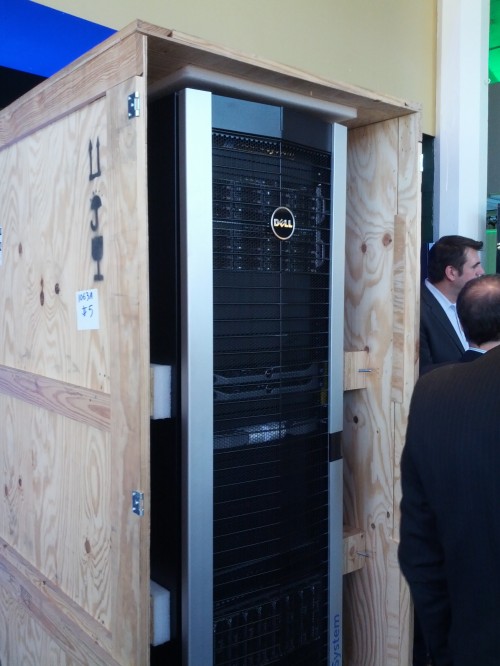 Dell's Active System 800: high-tech system packed in a low-tech crate.[/caption]
Dell's Active System 800: high-tech system packed in a low-tech crate.[/caption] Dell Touts Active Infrastructure All-in-One Solution
In a bid to stay competitive in the data center, Dell has announced a new standards-based, converged infrastructure offering it calls Active Infrastructure. The first pre-integrated offering in that portfolio is the Dell Active System 800, aimed at midmarket data centers. The new Active Infrastructure includes Dell’s PowerEdge M1000e chassis and 12th generation blade server, Dell Compellent or EqualLogic storage (including the EqualLogic blade array), and a new plug and play blade I/O module, the PowerEdge M I/O aggregator. Dell claimed that, all told, optimization at the system level could result in up to 45 percent better performance per watt than a similarly configured system from Cisco. The Active System 800 combines Dell’s iSCSI-accessible EqualLogic PS-6110 arrays, PowerEdge M620 servers, and new PowerEdge I/O Aggregator and Dell Force10 S4810 network switches, tied together via the Active System Manager. The result is a platform that combines template-based provisioning, infrastructure lifecycle management and guided user workflows, with tasks manageable via a single management console. In an Oct. 18 presentation, Dell highlighted its momentum as one of two vendors capable of offering servers, storage, networking and services in-house. “The other message in the last ten years we have been pretty good in figuring out the way in which our customers do business, and then we have invested or acquired and made it through the leaderboard,” said Arpit Joshipura, head of product management and marketing for Dell Networking. The Active System 800 requires 75 percent few steps from power-on to production, Dell claims, and can pack in 2.3 times more compute notes per rack thanks to its support for a quarter-height blade server. The 800 will be slotted within Dell’s other pre-integrated systems, the vStart range; Dario Zamarian, the vice president and general manager of the Converged Infrastructure and Networking Solutions group within Dell, positioned the 800 between the vStart 200 and 1000. Dell ships the 800 preloaded and configured with virtual machines. The template-based provisioning tool requires little more than inputting an IP address to set up, with the software automatically performing the rest of the necessary setup tasks. “The first thing [IT managers] typically do is go out and write down the service tag, what rack it was in, and what row I put it in,” Aaron Prince, with Dell AIM technical marketing, said in a presentation. “It’s a very manual process of cataloguing. This tool allows me to discover a chassis, point to a chassis, communicate via the out of band communication all of our equipment has, and we pull in that information on the fly. Set an IP, click ‘next,’ next,’ ‘next and it goes out and discovers these things.” [caption id="attachment_5325" align="aligncenter" width="500"]  Dell's Active System 800: high-tech system packed in a low-tech crate.[/caption]
Dell's Active System 800: high-tech system packed in a low-tech crate.[/caption]
 Dell's Active System 800: high-tech system packed in a low-tech crate.[/caption]
Dell's Active System 800: high-tech system packed in a low-tech crate.[/caption] 